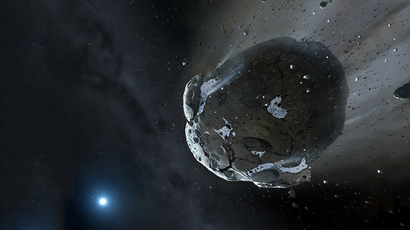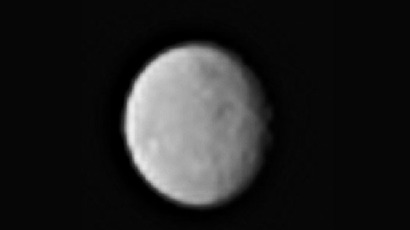Eyes in the skies: Mysterious bright spots on Ceres dwarf planet look like glowing eyes

Astronomers are puzzled by the latest images captured by NASA’s Dawn spacecraft. They show that there are two spots on Ceres that are much brighter than the rest of the dwarf planet’s rocky and pockmarked terrain.
The probe is due to enter Ceres’ orbit on March 6. It has already begun sending back the first photos of the dwarf planet that NASA has snapped since 2004. Back then, pictures from the Hubble Telescope showed a white area. Later, photos revealed that the white area is really a bright spot. Now scientists say there is a second, slightly dimmer, yet still noticeably bright spot next to the first…and they don’t know what’s causing them.
"Ceres' bright spot can now be seen to have a companion of lesser brightness, but apparently in the same basin. This may be pointing to a volcano-like origin of the spots, but we will have to wait for better resolution before we can make such geologic interpretations," Chris Russell, principal investigator for the Dawn mission, based at the University of California, Los Angeles, said in a NASA statement.

The photos were taken on February 19, from a distance of about 29,000 miles. They are part of a series taken as Dawn observed Ceres completing one full rotation ‒ one of the dwarf planet’s days, which lasts about nine hours.
"The brightest spot continues to be too small to resolve with our camera, but despite its size it is brighter than anything else on Ceres. This is truly unexpected and still a mystery to us," said Andreas Nathues, lead investigator for the framing camera team at the Max Planck Institute for Solar System Research in Gottingen, Germany.
The Dawn probe is set to begin a 16-month study of Ceres, the largest body in our solar system’s main asteroid belt, which floats between Mars and Jupiter. The dwarf planet has an average diameter of 590 miles (950 kilometers).
The images Dawn sends back will give scientists better and better views of Ceres. Researchers hope to gain a deeper understanding of its origin and evolution by studying its surface, including the mysterious bright spots.
“So what could the bright spots be, other than alien castaways signaling at us with flashlights?” Chris Taylor of Mashable asked.

Ceres is a water-heavy object believed to contain a large amount of ice. However, ice would reflect more than 40 percent of all light hitting it ‒ meaning the current amount of reflection that scientists have measured doesn’t add up. The difference may be accounted for by the resolution limit of Dawn's camera at this distance, Taylor reported. He added that salt patches or ice volcanoes are other potential causes of the glowing dots.
Images sent back to NASA in January were only 80 percent of Hubble’s resolution from over a decade ago, but new photos will be clearer as the probe gets closer to the dwarf planet.
Ceres falls into the same category of dwarf planets as Pluto. The classification, according to the International Astronomical Union, is for a celestial body that “is in orbit around the sun” and “has sufficient mass for its self-gravity to overcome rigid body forces so that it assumes a hydrostatic equilibrium (nearly round) shape,” but is not able to “clear the neighborhood around its orbit.”















